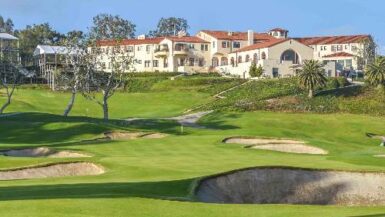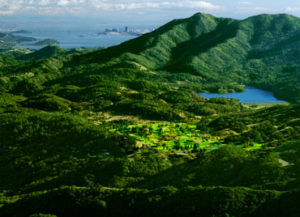
My golf buddy Ector and his wife Marta are in NoCal this week and brought their golf clubs with them from L.A. I played Casa de Campo with Ector, and had a blast. He’s one of those guys that you don’t care what he shoots, because he’s so much fun to play with, (even though he shoots 120). It also helped watching his eyes widen with wonder as I showed him around all of Pete Dye’s majestic back nine at Dye Fore. He loves golf to the marrow of his bones, and so when Ector inquired about where to play, I gladly set him up with an itinerary for this week.
When his golf friends saw it their eyes popped.
“What??!! You’re playing THERE??!!” They were so impressed, they actually coined a new phrase – “Pulling an Ector” is now slang for “getting on a super-sick golf course nobody gets to play.” I got a kick out of that: imagining friends excitedly shouting “I pulled an Ector! I pulled an Ector!”
And then it hit me: Earlier this week I wrote that you’d being able to play a fistful of courses better than Harding Park, site of this year’s PGA Championship. Since I talked the talk, I better walk the walk. Here’s the list I gave Ector, along with a little history about each. Some of them you can walk on today. Some of them…well put them on a list and keep on traveling and meeting other golfers. You can’t spit in California without hitting a terrific golf course, so persevere. You can’t pull an Ector if you don’t try.
MEADOW CLUB – FAIRFAX, CA
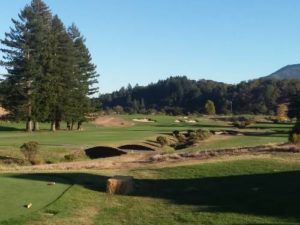
Jaws always drop when people first see an aerial view of Meadow Club, tucked cozily within the summit bowl of rugged Mount Tamilpaus, NoCal’s exquisite “maiden lying down” landform. Alister Mackanzie’s first North American golf design collaboration with Robert Hunter, Meadow Club is eminently natural, fairways flowing serenely between the high desert rocky slopes gracefully.
Like an eagle spying the world from its dizzyingly high eerie, Meadow Club is a Shangri-la of golf, sitting in lonely eminence amidst its desert spire, virtually unknown east of the San Andreas, but rapidly gaining a reputation due to a scintillating restoration spearheaded by architect Mike Devries and Head Superintendent Sean Tully. Fast and firm fairways are the result of excellent water conservation; Meadow Club’s sustainability is first rate, a model for any club in the country to emulate. Best of all, the course looks and plays like its 100 years old, and that’s the greatest compliment you can pay an architect and a superintendent.
Your Author’s favorite stretches of holes include the par-4s at two through four, which play along the rocky edge of the mountain bowl and 13-15, two side-by-side par-5s sandwiching a tiny, but gorgeous par-3. The par-5s are not separated by rough, but share a St. Andrews-style double fairway, so wild slices may end up in bunkers on the wrong hole or in the winding brook that wanders drunkenly between them.
Be sure to stay until sunset to hear the mournful howl of the coyotes as they begin their nightly prowl. And watch as a billion stars will light up the night sky so far away from civilization. This is golf on an edge of the world.
CALIFORNIA GOLF CLUB OF SAN FRANCISCO – S.F., CA

Cal Club to its friends is another magnificently restored work of Alister Mackenzie, who this time shares design credit with A.V. Macan. (Macan routed the golf course and built the greens, while Mackenzie designed the bunkering wall-to-wall.) Credit for the course’s renovation and resurgence goes to golf architect Kyle Phillips, an American architect perhaps better known overseas, as he has designed top 100 courses on the Scottish coast, the salt flats of Abu Dhabi, the mountains of Korea, and the Sicilian shoreline.
Not only did Phillips halt a devastating nematode infestation that threatened every green on the property, he also built several new holes in the same style and playability of Mackenzie and Macan. In the intervening century between the club’s founding in 1928 and Phillips’s 2011 restoration, several of the original golf holes were lost to eminent domain. The replacement holes, built in the early 1960s, never blended with or could equal the scale and sweep of Mackenzie and Macan’s work. By moving the club’s driving range to an unused plot in the middle of the golf course, Phillips designed two entirely new holes that were consistent in strategy and character with the rest of the course.
“They became two of the best holes on the course,” wrote Golf Club Atlas’ Ran Morrissett, speaking of the short, but dangerous par-4 seventh and par-3 eighth with its curvaceous green.
Immediately word spread like the Chicago fire: Cal Club may be the best golf restoration in the history of golf or restorations! Sure, Sleepy Hollow is knocking on that door right now as we speak, but that’s okay. Who wins that discussion? The American golfer that’s who!
MONTEREY PENINSULA COUNTRY CLUB – CARMEL, CA
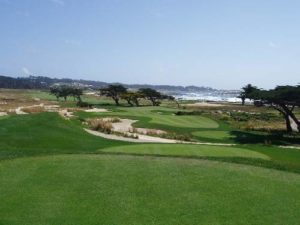
No other club in America except mighty Winged Foot outstrips sparkling Monterey Peninsula Country Club when it comes to having two courses as equally brilliant, gorgeous, and iconic. Winged Foot has major championship pedigree, but M.P.C.C. has miles and miles of glistening Pacific shoreline, along which so many greens and tees can precipitously cling. Set perfectly between Pebble Beach and Cypress Point, the Shore Course and the Dunes Course are as natural and idyllic a setting for golf as any place on Earth.
Mike Strantz’s Shore Course is, arguably, his magnum opus, the apex of his short, but incendiary career. Strantz knew he was building between Pebble and Cypress, and right next door to his favorite architect of all, Alister Mackenzie. Strantz delivered a course in complete harmony with both of those designs, as well as the natural surroundings and terrain. His redesign beloved by everyone who plays it, the course is now one of the host venues for the AT&T National. He died of oral cancer just a few short months after completing it. Family, friends, and fans of Strantz still keep small memorial shrines to his memory in their homes. “The Maverick” as he was known, had a heart as big as his reputation, and touched so many lives that people still find inspiration from his to this day. He’s gone, but he never left us.
Not to be outdone by his former design associate, Tom Fazio renovated the equally beautiful and strategic Dunes Course – originally a Seth Raynor, but muddled by many intervening hands. Fazio added both difficulty and beauty while also utilizing excellent strategic tee shots. Like the Shore course and Cypress Point, the Dunes course is a transitional routing. Starting in the forest, you play through several holes of dunescape – 9, 10, 11, and 12 – then reach the ocean for holes 13 through 15, before heading back inland and finishing in the forest.
A bucket list pair for any well-traveled golfer, M.P.C.C. is among the crème-de-la-crème of American golf, and also like Winged Foot, is an index of American history and society.
PASATIEMPO – SANTA CRUZ, CA
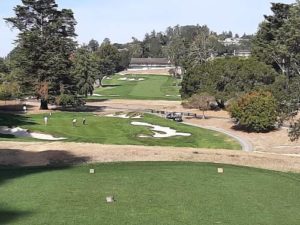
Spanish for “passing time,” a round at Pasatiempo is like reuniting with a dear old friend. Pasa is among the rarest of birds, a public-access Alister Mackenzie design. The man who built both Augusta National and Cypress Point designed precious few public courses, many of which no longer exist due to modern designers trying out their own ideas over Mackenzie’s canvas.
Happily, a Tom Doak restoration has re-polished Pasatiempo to its dazzling former self.
“Our mission statement at Pasatiempo was to restore the features of the golf course to the way they were on opening day in 1929 and not make any other changes,” said Doak in an earlier interview. “We put the bunkers back the way they were supposed to be based on the aerial photographs we had.”
Like a lookout in the crow’s nest spying the horizon, your opening tee shot is set against the backdrop of lovely Santa Cruz, and the round just gets more adventurous from there. Gargantuan bunkers, cavernous barancas, a century of golf history, and Mackenzie’s house on the side of the sixth fairway – so close you can check and see if he got mail as you play down the fairway – all make Pasatiempo so much more than a round a golf, but a walk through a golf time machine.
The burly, rumbling par-4s at 10 and 11 are two of the best back-to-back holes in all of golf, while the devilish 16th green made a seething Tiger Woods card a triple bogey seven after he didn’t carry the insidious false front…twice.
ALSO IN THE AREA
Presidio – This popular municipal course with the scimitar shaped driving range is surrounded by fragrant eucalyptus and cypress and features wonderfully rumpled fairways and excellent green contours. They actually opened as a public park during the pandemic.
Lake Merced – “I played the U.S. Junior at Lake Merced when I was 14,” sad Tiger Woods in his pre-PGA Championship press conference on Tuesday. I’ve had a few lost balls in trees at Lake Merced. That’s one of the tightest golf courses and most claustrophobic places that I’ve ever played. Yeah, I’ve lost a few there.” Even so, this course sits closer to Lake Merced than either Olympic Club or Harding and has an illustrious history.
Seascape – This little public course in Aptos punches far above its weight. A small version of Olympic Club, the course starts features both reverse camber as a defense and gets stronger as the course builds to a crescendo during the back nine. At $40 it’s a steal.
CordeValle – Set in the wine country about an hour from S.F., this resort hosted a wildly successful U.S. Women’s Open in 2016. Brittany Lang won her first major title in a playoff over Anna Nordqvist.


